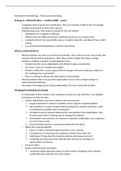Samenvatting
Samenvatting artikels Intervention Methodology
Artikels: Strategy as a Wicked Problem – Camillus (2008) Facilitated modelling in operational research – Franco & Montibeller (2008) Beyond Productivity loss in brainstorming groups: the evolution of question – Stroebe, Nijstad & Rietzschel (2010) Group model-building to support public ...
[Meer zien]








